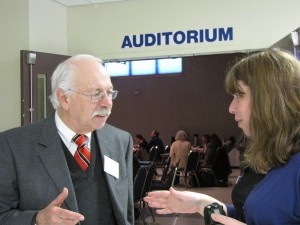
New Yorkers do it. Philadelphians do it. Even small communities in the tristate area do it. But can the towns and villages in the Hudson Valley do it? To learn to shed cars and embrace biking and walking as a means of transportation?
Not very well, if you look around. Save for the region”™s cities and villages, most developed areas are a new urbanist”™s nightmare ”“ houses on five-acre tracts, no sidewalks and little, if any, access to shopping doctors or public transportation that can be reached without an automobile.
The Orange County Citizens Foundation invited planners from Westchester to Ulster to its “Making Great Places” seminar, held at Mount St. Mary College on March 11 to swap stories, ideas and hopefully come out with a way to reintroduce the non-motorized wheel.
The seminar”™s goal was to brainstorm new and existing community projects under or proposed for  reconstruction, where residents could walk, bike or take public transportation to get across town- or across a bridge. There”™s also the challenge of getting local zoning and planning boards to buy into changing the landscape, even as the number of residents in the region swells.
Keynote speaker Mike Lydon, founder of The Street Plans Collaborative, based in New York and Miami, encouraged planners and designers to start thinking of ways to plan for people-oriented communities and pointed to the “explosion of bicycling in New York City. This trend holds true for other American cities,” Lydon said. “We need to reinforce walking and biking not just as a secondary means of transportation but as the preferred method wherever possible.”
Since the expansion of suburbia after World War II, the U.S. has become a nation reliant on the automobile, and the ensuing infrastructure has reflected that trend. The cost per pedestrian-friendly citizen is $150 in the U.S., compared with Amsterdam”™s cost of $35 per person.
Organizations such as The Street Plans Collaborative are not just talking the talk: the group has already ignited biking fire in Miami and worked with several cities and communities around the country to embrace street closures, create biking lanes next to major roadways and to getting local zoning and planning boards to think of the positives of non-motorized transportation.
In six years, Lydon told planners and municipal leaders attending the seminar, “The number of cities embracing the concept of dedicated street closures for pedestrians has tripled. Open streets are social and fun ”“ you don”™t have to worry about where you”™ll put your car or that your children will be run over ”“ and in the long term,” added Lydon, “the benefits include lower health care costs.”
Restructuring roads to make them pedestrian friendly, markers to make drivers aware of pedestrian crossings, pocket parks and benches along the way for people to enjoy are a way to tap into the human spirit and encourage non-motorized mobility. Choosing routes that will bring people into local shopping areas also help communities to get to know merchants they might otherwise drive by and to patronize their stores. Getting the local police departments involved and engaged in the process is also key to making a non-motorized community a success, Lydon said.
Westchester County, New York City and Hoboken, N.J., Â are areas where Lydon said neighborhoods, surrounding towns and villages were connecting people with non-motorized transportation ”“ “and it”™s working.”
One roadblock for those who like the idea of walkable communities are “building inspectors,” said Paddy Steinschneider of Dobbs Ferry. “ADA compliance is not the only consideration, but they can make it fairly difficult to make walkable communities happen … we have been trying to work to make Dobbs Ferry less reliant on cars and more pedestrian and biking friendly ”“ and it”™s been more than a challenge.”















